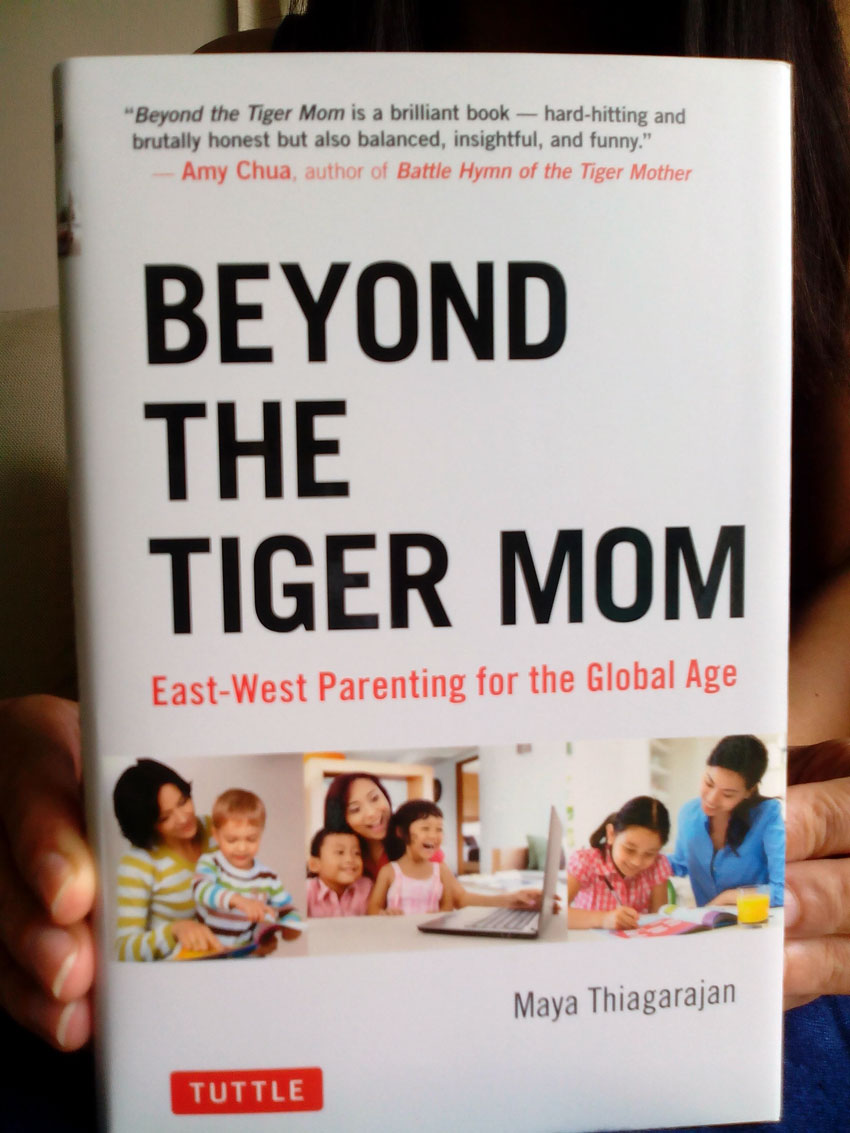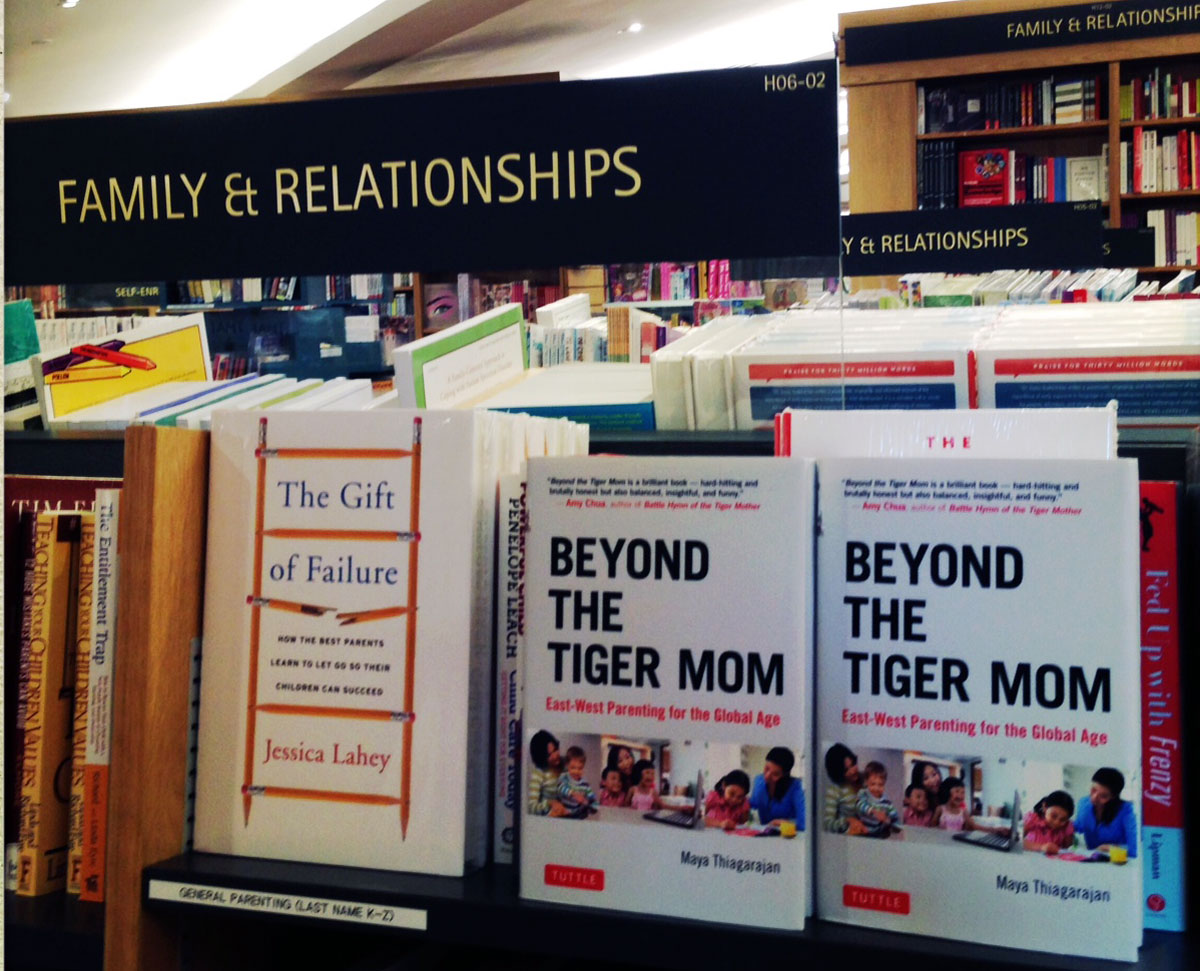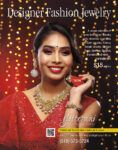EAST-WEST PARENTING IN THE GLOBAL ERA
“Beyond the Tiger Mom” at bookstores. (All photos: Courtesy Maya Thiagarajan)
Maya Thiagarajan describes the motivation for her book, “Beyond the Tiger Mom,” which offers global parents ways to combine the best of Eastern and Western approaches to parenting and education. Her book was released Feb. 23. (Lifestyle, @MayaThiagarajan, #MayaThiagarajan, #BeyondtheTigerMom, @BeyondtheTigerMom, @Siliconeer, #Siliconeer, #BookRelease, #ethnic, #parenting)
Toni Morrison once said, “If there’s a book you want to read, and no one has written it, then you must write it.” Since I really wanted to read a book that reflects the real life dilemmas and decisions of parents like myself – parents who have been exposed to East and West, parents who draw on multiple cultures when making decisions for their children – I began the long project of writing Beyond the Tiger Mom: East-West Parenting for the Global Age.
To start with, let me tell you a little bit about my story. In early 2010, my husband, children and I packed up all our stuff, waved goodbye to our cramped apartment in Manhattan, and flew across the world to Singapore.
This wasn’t my first cross-continental move: I was born and raised in India, but as a teenager, I moved to the U.S. for college, and then stayed on there for graduate school and work. I taught in private and public American schools for a decade, and I gave birth to both my children in the U.S. But after fifteen years in the U.S., I found myself hungering for “home.” I was yearning for tropical sun and heat, for the sounds of Tamil and Hindi, for idli-dosa breakfasts, and for the color and chaos of India. Since home – India – wasn’t really an option for my husband in terms of his career, we settled on Singapore, and so began the next phase in our global journey.
I began teaching at an international school in Singapore where most of my students were either South or East Asian. And over my time in Singapore, I became well acquainted with many local Singaporeans with children in the local school system. Needless to say, parents in Singapore differed greatly from the parents I had worked with in the U.S. The differences were dramatic: parents here had totally different ideas about discipline, math education, the role of memory, the goals of education, the role of competition… and the list goes on. And you know what? A lot of the things that these parents were doing were working really well.
So, to cut a long story short, I began writing Beyond the Tiger Mom to give Asian parents a voice and to offer all global parents suggestions on how to combine the best of Eastern and Western approaches to parenting and education.
Each chapter in the book revolves around a question that I found myself asking as I tried to understand Singaporean/Asian approaches to parenting and to discover the best way to blend Eastern and Western parenting and educational approaches.
For instance, one of the first things I noticed when I arrived on this island was the absolute obsession that mothers seemed to have with math education. “What do you do for math?” was a question that mothers on the island loved to discuss in great detail. In the U.S., I had found that early childhood education revolved largely around language (reading/speaking) and social skills; however, here in Singapore, mothers seemed determined to create a “math-rich home” for their young children and give their kids the best mathematical head start they possibly could. And all the data suggest that these approaches work really well. When it comes to math education, the world has a lot to learn from Asian moms!

Simultaneously I found that these parents seemed to devalue reading for pleasure, and the bedtime reading ritual that was so religiously observed by American parents seemed to be missing in Singapore. Why was this happening, I wondered? And what could Singaporean parents and educators learn from their American counterparts in this regard?
In my book, I explore parents’ attitudes towards math and reading, and I offer all parents suggestions for how to build homes that are rich in math and reading, and that offer children the strong foundations they need to be successful in both areas.
In addition to examining approaches to academics, I also look at a range of other questions: the role of tuition, enrichment, and exams; parents’ approaches to failure; and the way kids’ value systems are shaped by cultural forces such as stories, myths, and media. In fact, my favorite chapter is the one that examines how the stories we tell our kids and the messages we give them when they are very young shape their value systems in fundamental ways. How do Indian and Chinese stories – myths, movies, and metaphors – offer children scripts that idealize family bonds and filial piety? How are these stories different from American/Western stories? How can we give our kids the best of both worlds?
The thesis of my book is that both Western and Eastern approaches to parenting and education have tremendous value, and a global parent in the 21st century can and should successfully blend the best of both to raise well-balanced children.


